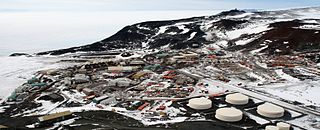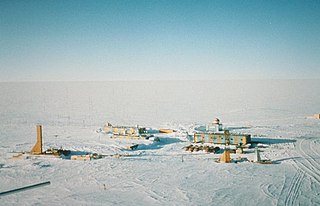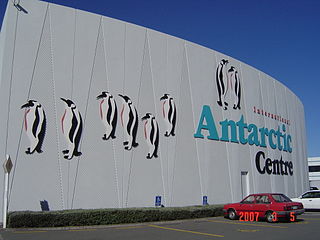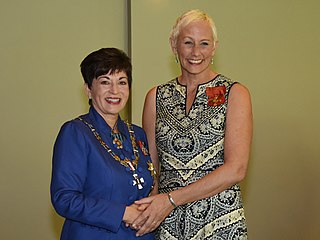
The history of Antarctica emerges from early Western theories of a vast continent, known as Terra Australis, believed to exist in the far south of the globe. The term Antarctic, referring to the opposite of the Arctic Circle, was coined by Marinus of Tyre in the 2nd century AD.

The Ross Dependency is a region of Antarctica defined by a sector originating at the South Pole, passing along longitudes 160° east to 150° west, and terminating at latitude 60° south. It is claimed by New Zealand, a claim accepted only by the other six countries with territorial claims in Antarctica. Under the 1961 Antarctic Treaty, of which all territorial claimants are signatories, including New Zealand, all claims are held in abeyance. Article IV states: "No acts or activities taking place while the present Treaty is in force shall constitute a basis for asserting, supporting or denying a claim to territorial sovereignty in Antarctica or create any rights of sovereignty in Antarctica".

McMurdo Station is a United States Antarctic research station on the south tip of Ross Island, which is in the New Zealand-claimed Ross Dependency on the shore of McMurdo Sound in Antarctica. It is operated by the United States through the United States Antarctic Program (USAP), a branch of the National Science Foundation. The station is the largest community in Antarctica, capable of supporting up to 1,200 residents, and serves as one of three year-round United States Antarctic science facilities. All personnel and cargo going to or coming from Amundsen–Scott South Pole Station first pass through McMurdo. McMurdo Station continues to operate as the hub for American activities on the Antarctic continent. By road, McMurdo is 3 kilometres (1.9 mi) from New Zealand's smaller Scott Base.

Scott Base is a New Zealand Antarctic research station at Pram Point on Ross Island near Mount Erebus in New Zealand's Ross Dependency territorial claim. It was named in honour of Captain Robert Falcon Scott, RN, leader of two British expeditions to the Ross Sea area of Antarctica. The base was set up as support to field research and the centre for research into earth sciences, and now conducts research in many fields, operated by Antarctica New Zealand.

Vostok Station is a Russian research station in inland Princess Elizabeth Land, Antarctica. Founded by the Soviet Union in 1957, the station lies at the southern Pole of Cold, with the lowest reliably measured natural temperature on Earth of −89.2 °C. Research includes ice core drilling and magnetometry. Vostok was named after Vostok, the lead ship of the First Russian Antarctic Expedition captained by Fabian von Bellingshausen. The Bellingshausen Station was named after this captain.

McMurdo Sound, a sound in Antarctica, is the southernmost navigable body of water in the world, located approximately 1,300 kilometres (810 mi) from the South Pole.
Hugh MacDonald is a film director from New Zealand. He has worked on films for the Government National Film Unit including travel films and historical drama The Governor. He has been nominated for an Academy Award for Animated Short Film as producer.

NHNZ, formerly Natural History New Zealand, is a New Zealand-based television production house.

The International Antarctic Centre is a visitor attraction and public science discovery centre in the suburb of Harewood, Christchurch, New Zealand. It is located at Christchurch International Airport, adjacent to the buildings that are the Christchurch base for the Antarctic programmes of the USA, New Zealand and Italy.

Timothy Raymond Naish is a New Zealand glaciologist and climate scientist who has been a researcher and lecturer at Victoria University of Wellington and the Director of the Antarctic Research Centre, and in 2020 became a programme leader at the Antarctic Science Platform. Naish has researched and written about the possible effect of melting ice sheets in Antarctica on global sea levels due to high CO2 emissions causing warming in the Southern Ocean. He was instrumental in establishing and leading the Antarctica Drilling Project (ANDRILL), and a Lead Author on the Intergovernmental Panel on Climate Change (IPCC) 5th Assessment Report (2014).

Leanne Pooley ONZM is a Canadian filmmaker based in Auckland, New Zealand. Pooley was born and raised in Winnipeg, Manitoba, Canada, she immigrated to New Zealand in the mid-1980s and began working in the New Zealand television and film industry before moving to England where she worked for many of the world's top broadcasters. She returned to New Zealand in 1997 and started the production company Spacific Films. Her career spans more than 25 years and she has won numerous international awards. Leanne Pooley was made a New Zealand Arts Laureate in 2011 and an Officer of the New Zealand Order of Merit in the New Year's Honours List 2017. She is a member of The Academy of Motion Picture Arts and Sciences.
The New Zealand International Film Festival (NZIFF) (Māori: Whānau Mārama) is a film festival held annually across New Zealand throughout the latter half of the year, starting in Auckland in July.

Encounters at the End of the World is a 2007 American documentary film by Werner Herzog about Antarctica and the people who choose to spend time there. It was released in North America on June 11, 2008, and distributed by ThinkFilm. At the 81st Academy Awards, the film was nominated for Best Documentary Feature.

Michelle Rogan-Finnemore is a New Zealand-American science administrator, and currently the Executive Secretary of the Council of Managers of National Antarctic Programmes (COMNAP) which is the international association which brings together the National Antarctic Programs that make up its members. She is also the namesake of Finnemore Peak.

Nancy Bertler is an Antarctic researcher, who has led major initiatives to investigate climate history using Antarctic ice cores, and best known for her leadership of the Roosevelt Island Climate Evolution Programme (RICE). She is a full professor at the Antarctic Research Centre at Victoria University of Wellington in New Zealand.
Anne Veronica Goldson is a New Zealand journalism and film academic specialising in documentaries. Her films include Punitive Damage, Georgie Girl, Brother Number One and Kim Dotcom: Caught in the Web.

Winston Cowie is a Marine conservationist, author and film director.

Richard Levy is a New Zealand glacial stratigrapher and paleoclimatologist with expertise in microfossil analysis. As a principal scientist at GNS Science he has been involved in international and New Zealand environmental research programmes focussing on the evolution of the Earth's climate and building an understanding of the role of greenhouse gases in causing anthropogenic climate changes, in particular those impacting global sea levels. He has had extensive experience in scientific drilling, leading major projects, including the ANtarctic geological DRILLing (ANDRILL) Program in Antarctica. Since 2018, Levy has co-led the government funded NZ SeaRise programme.















